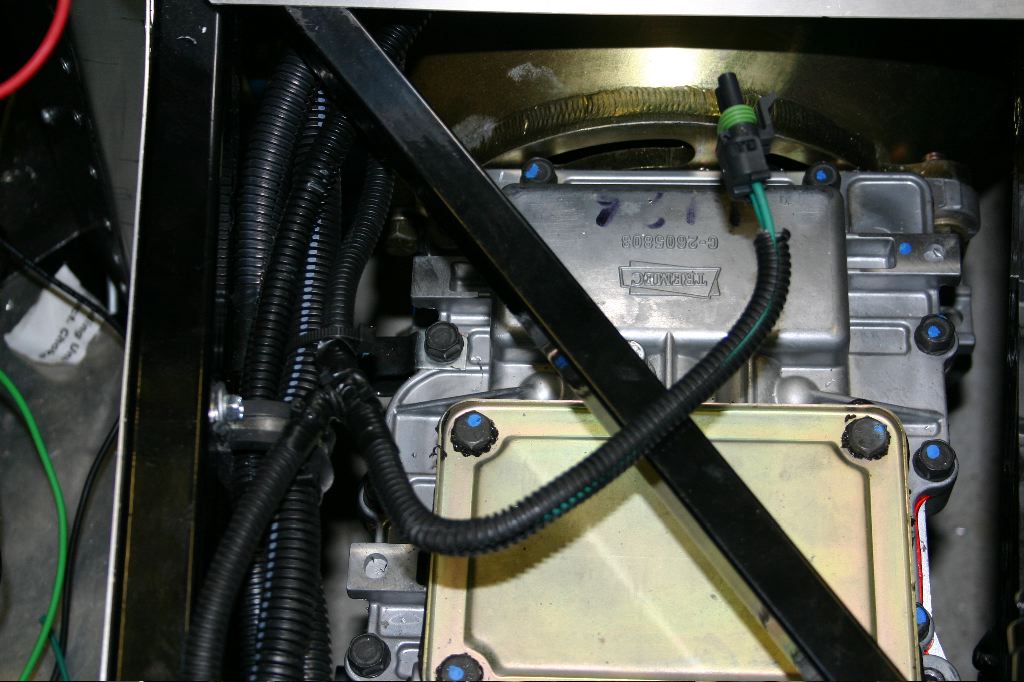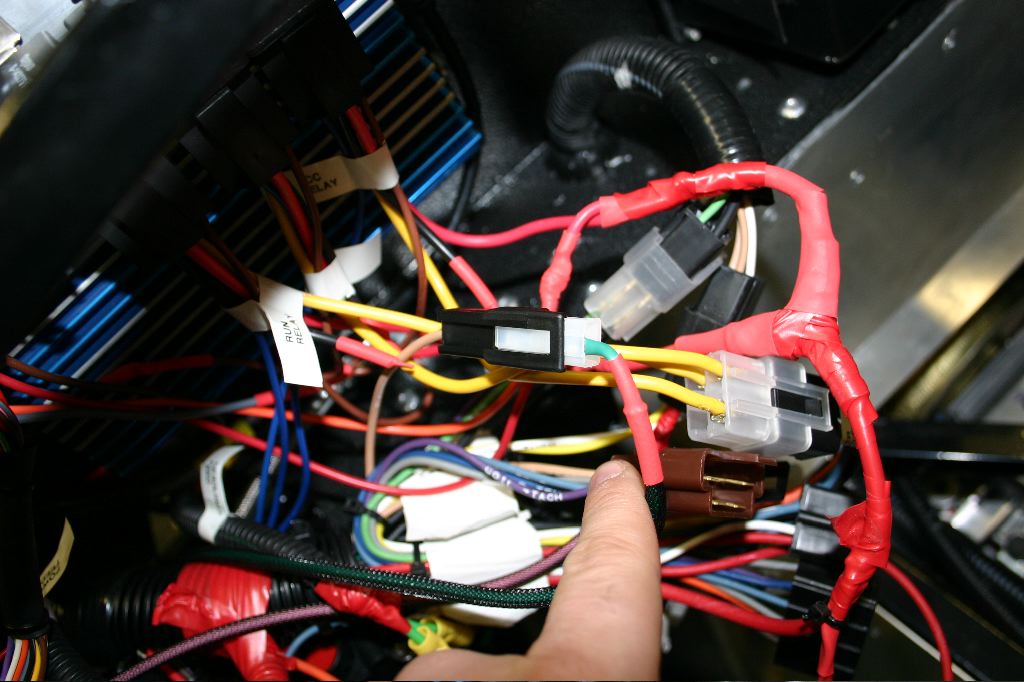Because I’m working on so many different things each day this week, rather than a witty subject for my posts, I’ll just periodically post an update with what I’ve been working on. Its a rather nasty rainy day today, and holed up in the garage I’ve gotten a good bit of stuff done. I started off the day wanting to get the new wiring for the backup light installed and to get the trunk buttoned up. While I’m not done for the day, I’m taking a break and wanted to post an update.
The backup/reverse light is something that isn’t standard on the Factory Five cars. I’m not sure why that is, and I’m not sure if its really required in New Hampshire, but of all the things that could trip me up with inspections in the future, it would be one of the hardest to easily retrofit, so in it goes. If I can manage to find one, the plan is to use a single light from a Mini Cooper (new BMW-built ones, not the original ones) in the middle of the rear body of the car.
The switch in the transmission can handle 5 amps, which is plenty for a backup light, particularly if its a single unit with LEDs. Because of that, I decided to not install a relay for it and to just wire power to the switch and then the switch to the rear of the car.

To start the wiring, I needed to add another fused circuit. The extension fuse block in the drivers footbox was full with the headlight fuses and the EFI fuses. I had a second fuse block which clips onto the existing one, so I figured I’d jumper power from the first one to the second one and have room for four more fuses. To start I pulled out the bus bar in the existing block and soldered a ten gauge jumper wire to it. The other end went onto the matching bar in the second fuse block.

The fuse block went in just fine. (The three yellow 20 amp fuses in the above photo are for the ECU and the two HID ballasts, the gray 5 amp one is the “run” power feed for the ECU.)

To run the power to the switch on the transmission, I ran a new green wire from the fuse block, and added it into the Ron Francis alternator/solenoid harness. Six inches before the end of it, I put a T into the loom and ran the wire into the transmission tunnel.

The loom in the transmission tunnel has a T in it as well. The power from the fuse block goes down to the WeatherPak connector, then the wire returns to the main harness and runs to the rear of the car.
“George”, you may be asking yourself, “that doesn’t make sense… that circuits got constant-on power!” — You’d be right. Around the time I got this far I realized that I had made a rookie mistake with the wiring and the four new fuse slots were all being fed with power straight from the battery. That’s great for things like powering the ECU or providing power to the relays for the headlights (and I’ll be able to use one for the relay that powers the parking lights, I think…), but its not so good for backup lights. Why? If I leave the car in reverse while I’m parked, the lights would be on even if the car is off. Obviously that’s bad.

After doing some poking around the Ron Francis wiring diagram, and asking a question on the FFCobra forums, I realized the “Electric Choke” circuit in the harness (which is on a switched part of the primary fuse block) is not used with an EFI setup like mine. A quick pinch of the male terminal in the Ron Francis connector, and a snip and resoldering of a female connector onto the backup light circuit and the two clipped right together.
For future reference, the fuel pump circuit is also not being used, so I still have another fused spot if I find the need for another one (and I may reuse it as the parking light circuit). As part of this I also realized that the inertia switch is no longer wired into the fuel pump circuit, although honestly without a carb I don’t think thats a big problem.

The new wire bundle (and bundle is a big of a misnomer since its just one wire) was zip-tied to the existing three bundles running to the back of the car. Originally I was going to bundle two RCA cables and an amp trigger wire in with it, but both the power feed from the battery and the alternator feed back to it are bundled right there and I think I’d get too much noise from it. The e-brake blocks the passenger side of the tunnel, so I think I’ll have to run stereo lines under the carpet on the passenger side, and into the rear of the car to keep them at some distance from the alternator line.

Right now I left a few feet of wire just hanging out the rear of the car. I’m not sure yet how the light will be mounted, so I didn’t want to end up short any wire.

I was at the point where I could start wrapping up all the wiring in the trunk. A few weeks ago I had disconnected all the power wiring and needed to get it all hooked back up. When I was wiring the power feeds to the disconnect switch, I discovered that I couldn’t fit the power line, the alternator line and the amp power onto the stud on the switch, with a lock washer and the nut. In the photo above, the silver connector was the original battery power feed, which came on the cable from Factory Five. The connector was a good 1/8 to 3/16th of an inch thick. To get more room on the stud, I lopped it off and crimped/soldered on the copper fitting on the right.

With the new connector, everything fit on the switch. I also decided I wanted to put a slightly larger grommet in the trunk floor for the power feed, so I drilled out the hole to 7/8″ and put a slightly larger grommet into it.

With all the wiring buttoned up, it was time to rivet the upper trunk floor in. This was, honestly, a pretty nerve wracking moment. With the floor riveted in, I could no longer easily reach any of the mechanics or wiring in the rear of the car. It may sound silly, but it was a mental point of no return.
On went the silicone bead, and down went the floor. Twenty five million rivets later, and the floor was riveted down. Once it was riveted, I also bolted in the passenger rollbar mount, but managed to forget to take a photo of that.

To seal the trunk better, I wanted to get a good bead of silicone around the seatbelt mounts and the rollbar mounts. The gaps around the seatbelt mounts was small, and could be just caulked. The gaps around the rollbars were almost a quarter inch. To get a seal around them, I used some painter’s tape from below and used it to support the caulk while it dries.

With the tape on, the caulk would stay put.

The trunk is done now. In fact, with the exception of the light wiring, the whole rear end of the car is done now.

The next step is to get the rear wall of the cockpit installed. I’ll probably start this this evening, but I’m fairly tired and will likely not finish it because virtually none of the holes in the chassis are drilled. I need to hit Lowes and pick up a few more 1/8″ bits. I finally broke the last of the five I bought from Cokid two years ago.
I was going to put the body on the car tonight and work on the light wiring, but I’ve decided to wait until Wednesday to do that. Tonight I’ll do some sheetmetal work, and do some odds and ends. Tomorrow I’ll focus on dash gauge sensor wiring and dash wiring. Conservatively I’ll work on testing wiring on Wednesday, since its vastly different now than the RF harness and there’s a lot of new stuff to test. If I get the body on Wednesday night, then Thursday I can do lighting work. Friday the wire harness for the ignition shows up, and hopefully I’ll have a new distributor by then.
Saturday is a local Cobra get-together for breakfast. If everything goes perfectly this week, I may try to convince one or two of the guys to come back after and help me first-start the motor. I won’t feel at all bad if I don’t do that this week, though.